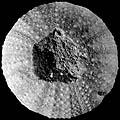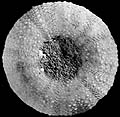The Echinoid Directory
Thieulinipedina Vadet, Nicolleau & Pineau 1996, p. 43
| Diagnostic Features |
|
|---|---|
| Distribution | Middle Jurassic (Callovian) of France and Portugal. |
| Name gender | feminine |
| Type | Pedina antiqua Cotteau, 1883, by original designation. |
| Species Included |
|
| Classification and/or Status |
|
| Remarks |
|




